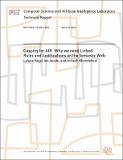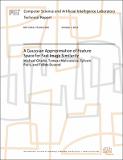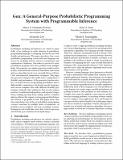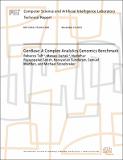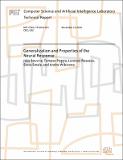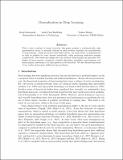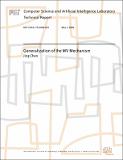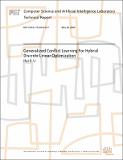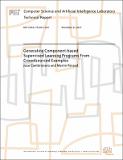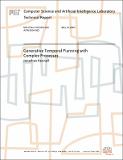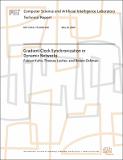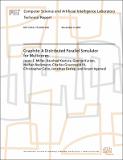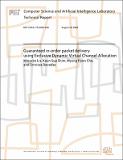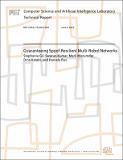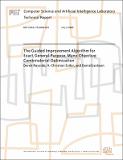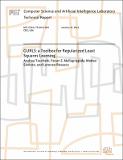Browsing CSAIL Technical Reports (July 1, 2003 - present) by Title
Now showing items 295-314 of 775
-
Gasping for AIR Why we need Linked Rules and Justifications on the Semantic Web
(2011-04-16)The Semantic Web is a distributed model for publishing, utilizing and extending structured information using Web protocols. One of the main goals of this technology is to automate the retrieval and integration of data and ... -
A Gaussian Approximation of Feature Space for Fast Image Similarity
(2012-10-01)We introduce a fast technique for the robust computation of image similarity. It builds on a re-interpretation of the recent exemplar-based SVM approach, where a linear SVM is trained at a query point and distance is ... -
Gen: A General-Purpose Probabilistic Programming System with Programmable Inference
(2018-11-26)Probabilistic modeling and inference are central to many fields. A key challenge for wider adoption of probabilistic programming languages is designing systems that are both flexible and performant. This paper introduces ... -
GenBase: A Complex Analytics Genomics Benchmark
(2013-11-19)This paper introduces a new benchmark, designed to test database management system (DBMS) performance on a mix of data management tasks (joins, filters, etc.) and complex analytics (regression, singular value decomposition, ... -
Generalization and Properties of the Neural Response
(2010-11-19)Hierarchical learning algorithms have enjoyed tremendous growth in recent years, with many new algorithms being proposed and applied to a wide range of applications. However, despite the apparent success of hierarchical ... -
Generalization in Deep Learning
(2018-05-01)With a direct analysis of neural networks, this paper presents a mathematically tight generalization theory to partially address an open problem regarding the generalization of deep learning. Unlike previous bound-based ... -
Generalization of the MV Mechanism
(2008-05-01)Micali and Valiant proposed a mechanism for combinatorial auctions that is dominant-strategy truthful, guarantees reasonably high revenue, and is very resilient against collusions. Their mechanism, however, uses as a ... -
Generalized Conflict Learning For Hybrid Discrete Linear Optimization
(2005-05-20)Conflict-directed search algorithms have formed the core of practical, model-based reasoning systems for the last three decades. In many of these applications there is a series of discrete constraint optimization problems ... -
Generating Component-based Supervised Learning Programs From Crowdsourced Examples
(2017-12-21)We present CrowdLearn, a new system that processes an existing corpus of crowdsourced machine learning programs to learn how to generate effective pipelines for solving supervised machine learning problems. CrowdLearn uses ... -
Generating Trees of (Reducible) 1324-avoiding Permutations
(2003-10-09)We consider permutations that avoid the pattern 1324. We give exact formulas for thenumber of reducible 1324-avoiding permutations and the number of {1324, 4132, 2413, 3241}-avoiding permutations. By studying the generating ... -
Generative Temporal Planning with Complex Processes
(2004-05-18)Autonomous vehicles are increasingly being used in mission-critical applications, and robust methods are needed for controlling these inherently unreliable and complex systems. This thesis advocates the use of model-based ... -
GeoQuorums: Implementing Atomic Memory in Mobile Ad Hoc Networks
(2004-02-25)We present a new approach, the GeoQuorums approach, for implementing atomic read/write shared memoryin mobile ad hoc networks. Our approach is based on associating abstract atomic objects with certain geographiclocations. ... -
Gestural Cues for Sentence Segmentation
(2005-04-19)In human-human dialogues, face-to-face meetings are often preferred over phone conversations.One explanation is that non-verbal modalities such as gesture provide additionalinformation, making communication more efficient ... -
Gesture in Automatic Discourse Processing
(2008-05-07)Computers cannot fully understand spoken language without access to the wide range of modalities that accompany speech. This thesis addresses the particularly expressive modality of hand gesture, and focuses on building ... -
Gradient Clock Synchronization in Dynamic Networks
(2009-05-29)Over the last years, large-scale decentralized computer networks such as peer-to-peer and mobile ad hoc networks have become increasingly prevalent. The topologies of many of these networks are often highly dynamic. This ... -
Graphite: A Distributed Parallel Simulator for Multicores
(2009-11-09)This paper introduces the open-source Graphite distributed parallel multicore simulator infrastructure. Graphite is designed from the ground up for exploration of future multicore processors containing dozens, hundreds, ... -
Guaranteed in-order packet delivery using Exclusive Dynamic Virtual Channel Allocation
(2009-08-18)In-order packet delivery, a critical abstraction for many higher-level protocols, can severely limit the performance potential in low-latency networks (common, for example, in network-on-chip designs with many cores). While ... -
Guaranteeing Spoof-Resilient Multi-Robot Networks
(July 2015)Multi-robot networks use wireless communication to provide wide-ranging services such as aerial surveillance and unmanned delivery. However, effective coordination between multiple robots requires trust, making them ... -
The Guided Improvement Algorithm for Exact, General-Purpose, Many-Objective Combinatorial Optimization
(2009-07-03)This paper presents a new general-purpose algorithm for exact solving of combinatorial many-objective optimization problems. We call this new algorithm the guided improvement algorithm. The algorithm is implemented on top ... -
GURLS: a Toolbox for Regularized Least Squares Learning
(MIT CSAIL, 2012-01-31)We present GURLS, a toolbox for supervised learning based on the regularized least squares algorithm. The toolbox takes advantage of all the favorable properties of least squares and is tailored to deal in particular with ...

